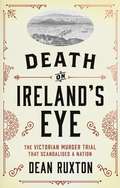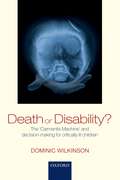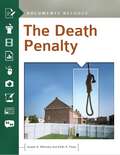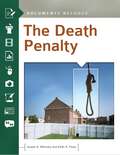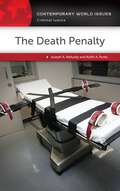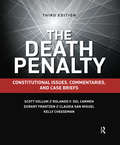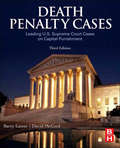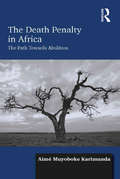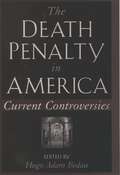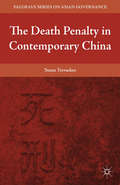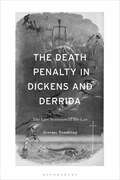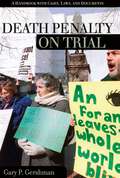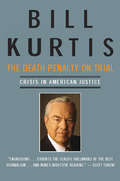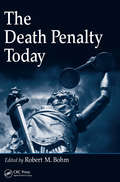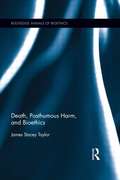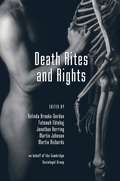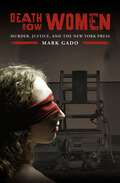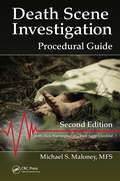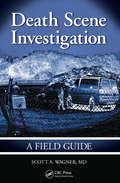- Table View
- List View
Death on Ireland's Eye: The Victorian Murder Trial that Scandalised a Nation
by Dean RuxtonA tragic death, a murder trial and a 170-year-old mystery – but what really happened?Shortly after Maria Kirwan died in a lonely inlet on Ireland’s Eye, it was decided that she had drowned accidentally during a day spent with her husband on the picturesque island. This inquest verdict appeared to conclude the melancholy events that consumed the fishing village of Howth, Co Dublin, in September 1852.But not long afterwards, suspicion fell upon Maria’s husband, William Burke Kirwan, as whispers of unspeakable cruelty, an evil character and a secret life rattled through the streets of Dublin. Investigations led to William's arrest and trial for murder.The story swelled into one of the most bitterly divisive chapters in the dark annals of Irish criminal history. Yet questions remain: Does the evidence stand up? What role did the heavy hand of Victorian moral outrage play? Was William really guilty of murder, or did the ever-present ‘moral facts’ fill in gaps where hard proof was absent?Now, this compelling modern analysis revisits the key evidence, asking sober questions about the facts, half-facts and fantasies buried within the yellowed pages of the Ireland’s Eye case files.
Death Or Disability?: The 'carmentis Machine' And Decision-making For Critically Ill Children
by Dominic WilkinsonIn ancient Rome parents would consult the priestess Carmentis shortly after birth to obtain prophecies of the future of their newborn infant. Today, parents and doctors of critically ill children consult a different oracle. Neuroimaging provides a vision of the child's future, particularly of the nature and severity of any disability. Based on the results of brain scans and other tests doctors and parents face heart-breaking decisions about whether or not to continue intensive treatment or to allow the child to die. Paediatrician and ethicist Dominic Wilkinson looks at the profound and contentious ethical issues facing those who work in intensive care caring for critically ill children and infants. When should infants or children be allowed to die? How accurate are predictions of future quality of life? How much say should parents have in these decisions? How should they deal with uncertainty about the future? He combines philosophy, medicine and science to shed light on current and future dilemmas.
The Death Penalty: Documents Decoded (Documents Decoded)
by Joseph A. Melusky Keith A. PestoWhen is the death penalty considered "cruel and unusual punishment" or "constitutionally permissible"? This book exposes readers directly to landmark opinions of the U.S. Supreme Court that strive to answer difficult questions regarding capital punishment.This book provides far more than an effective overview of the history, current status, and future of capital punishment in America; it supplies excerpts of the words of the justices themselves to make these judicial opinions readily accessible and understandable to general audiences. As a result, readers can see what the justices had to say for themselves regarding more than 30 important cases involving the death penalty—without relying on any intermediary interpretations of their statements. After a brief historical summary of the debate over capital punishment and the arguments favoring and opposing capital punishment, the book "decodes" how the justices have interpreted and applied constitutional provisions to historical and contemporary controversies. Each case includes brief narrative commentaries inserted by the authors to provide context for the justices' words. Additionally, the excerpted judicial opinions are presented as primary source documents for the reader's inspection and reflection.
The Death Penalty: Documents Decoded (Documents Decoded)
by Joseph A. Melusky Keith A. PestoWhen is the death penalty considered "cruel and unusual punishment" or "constitutionally permissible"? This book exposes readers directly to landmark opinions of the U.S. Supreme Court that strive to answer difficult questions regarding capital punishment.This book provides far more than an effective overview of the history, current status, and future of capital punishment in America; it supplies excerpts of the words of the justices themselves to make these judicial opinions readily accessible and understandable to general audiences. As a result, readers can see what the justices had to say for themselves regarding more than 30 important cases involving the death penalty—without relying on any intermediary interpretations of their statements. After a brief historical summary of the debate over capital punishment and the arguments favoring and opposing capital punishment, the book "decodes" how the justices have interpreted and applied constitutional provisions to historical and contemporary controversies. Each case includes brief narrative commentaries inserted by the authors to provide context for the justices' words. Additionally, the excerpted judicial opinions are presented as primary source documents for the reader's inspection and reflection.
The Death Penalty: A Reference Handbook (Contemporary World Issues)
by Joseph A. Melusky Keith A. PestoThis book addresses the myriad controversies and examines the evidence regarding capital punishment in America. It answers questions regarding topics like the efficacy of capital punishment in deterring violent crime, the risks of mistakes, legal issues related to capital punishment, and the monetary costs of keeping inmates on death row.Does the possibility of being put to death deter crime? Do the methods of execution matter? Is it possible for a state-ordered execution to be botched? Are innocent people ever sent to death row? Are there racial biases or other prejudices associated with the death penalty? This book examines the history of capital punishment in the United States; describes the significant issues, events, and cases; and addresses the controversies and legal issues surrounding capital punishment, making this important topic accessible to a wide range of readers.The book presents both sides of the argument on whether capital punishment should continue or be abolished, looking at the evidence regarding whether it is necessary for carrying out justice and deterring violent crime or whether the practice is inhumane, ineffective, biased in its application, and costly. Readers will gain insights into how capital punishment should be used, if at all; whether effective safeguards are in place to ensure that only the guilty receive the death penalty; what crimes deserve this sentence; whether juveniles or individuals with diminished mental capacity should ever be sentenced to death; potentially viable alternatives to the death penalty; and the hidden costs involved in our capital punishment system that make it so expensive. The book also contains primary documents relevant to capital punishment, such as excerpts from documents like the U.S. Constitution, the Hittite case laws, and the Code of Hammurabi, as well as descriptions of and excerpts from key cases decided by the U.S. Supreme Court.
The Death Penalty: A Reference Handbook (Contemporary World Issues)
by Joseph A. Melusky Keith A. PestoThis book addresses the myriad controversies and examines the evidence regarding capital punishment in America. It answers questions regarding topics like the efficacy of capital punishment in deterring violent crime, the risks of mistakes, legal issues related to capital punishment, and the monetary costs of keeping inmates on death row.Does the possibility of being put to death deter crime? Do the methods of execution matter? Is it possible for a state-ordered execution to be botched? Are innocent people ever sent to death row? Are there racial biases or other prejudices associated with the death penalty? This book examines the history of capital punishment in the United States; describes the significant issues, events, and cases; and addresses the controversies and legal issues surrounding capital punishment, making this important topic accessible to a wide range of readers.The book presents both sides of the argument on whether capital punishment should continue or be abolished, looking at the evidence regarding whether it is necessary for carrying out justice and deterring violent crime or whether the practice is inhumane, ineffective, biased in its application, and costly. Readers will gain insights into how capital punishment should be used, if at all; whether effective safeguards are in place to ensure that only the guilty receive the death penalty; what crimes deserve this sentence; whether juveniles or individuals with diminished mental capacity should ever be sentenced to death; potentially viable alternatives to the death penalty; and the hidden costs involved in our capital punishment system that make it so expensive. The book also contains primary documents relevant to capital punishment, such as excerpts from documents like the U.S. Constitution, the Hittite case laws, and the Code of Hammurabi, as well as descriptions of and excerpts from key cases decided by the U.S. Supreme Court.
The Death Penalty: Constitutional Issues, Commentaries, and Case Briefs
by Scott Vollum Rolando V. del Carmen Durant Frantzen Claudia San Miguel Kelly CheesemanThe Death Penalty, Third Edition, brings together all the legal issues related to the death penalty and provides case briefs for the most important United States Supreme Court death penalty cases. No other book available brings together a discussion of the major constitutional issues surrounding the death penalty with a broad array of associated case briefs. The authors classify cases according to legal issues and provide a commentary on the various sub-topics, presenting legal materials in an easily understood form. Though the primary audiences of the book are undergraduates in criminal justice programs and practitioners in the corrections and justice systems, the book will also prove useful to anyone who has an interest in the death penalty, the criminal justice system, or the United States Constitution. Every chapter starts with commentaries regarding general case law in a sub-topic, such as aggravating and mitigating factors, followed by a chart of the cases briefed in the chapter, and then the case briefs. These case briefs acquaint the reader with Supreme Court cases by summarizing facts, issues, reasons, and holdings. The Death Penalty, Third Edition , is a succinct, trusted guide to the law of capital punishment in the United States.
The Death Penalty: Constitutional Issues, Commentaries, and Case Briefs
by Scott Vollum Rolando V. del Carmen Durant Frantzen Claudia San Miguel Kelly CheesemanThe Death Penalty, Third Edition, brings together all the legal issues related to the death penalty and provides case briefs for the most important United States Supreme Court death penalty cases. No other book available brings together a discussion of the major constitutional issues surrounding the death penalty with a broad array of associated case briefs. The authors classify cases according to legal issues and provide a commentary on the various sub-topics, presenting legal materials in an easily understood form. Though the primary audiences of the book are undergraduates in criminal justice programs and practitioners in the corrections and justice systems, the book will also prove useful to anyone who has an interest in the death penalty, the criminal justice system, or the United States Constitution. Every chapter starts with commentaries regarding general case law in a sub-topic, such as aggravating and mitigating factors, followed by a chart of the cases briefed in the chapter, and then the case briefs. These case briefs acquaint the reader with Supreme Court cases by summarizing facts, issues, reasons, and holdings. The Death Penalty, Third Edition , is a succinct, trusted guide to the law of capital punishment in the United States.
Death Penalty Cases: Leading U.S. Supreme Court Cases on Capital Punishment
by Barry LatzerDeath Penalty Cases presents significant verbatim excerpts of death-penalty decisions from the United States Supreme Court. The first chapter introduces the topics discussed throughout the book. It also includes a detailed history of the death penalty in the United States. After this introduction, the remaining eighteen chapters are divided into five parts: Foundational Cases, Death-Eligible Crimes and Persons, The Death Penalty Trial, Post-Conviction Review, and Execution Issues. The first part, consisting of five chapters, talks about the mandatory death penalty, mitigating evidence and racial bias. The next part covers death-eligible crimes, such as rape and other crimes that do not involve homicide and murder. The middle part presents the trial process, from choosing the appropriate decision-makers through the sentencing decision. Followed by this is a chapter focusing on the aftermath of conviction, such as claims of innocence. The book concludes by exploring issues related to execution, such as not executing insane convicts. Finally, execution methods are presented. Provides the most recent case material--no need to supplementTopical organization of cases provides a more logical organization for structuring a courseCo-authors with different perspectives on the death penalty assures complete impartiality of the materialProvides the necessary historical background, a clear explanation of the current capital case process, and an impartial description of the controversies surrounding the death penaltyProvides the latest statistics relevant to discussions on the death penaltyClearly explains the different ways in which the states process death penalty cases, with excerpts of the most relevant statutes
The Death Penalty in Africa: The Path Towards Abolition
by Aimé Muyoboke KarimundaHuman development is not simply about wealth and economic well-being, it is also dependent upon shared values that cherish the sanctity of human life. Using comparative methods, archival research and quantitative findings, this book explores the historical and cultural background of the death penalty in Africa, analysing the law and practice of the death penalty under European and Asian laws in Africa before independence. Showing progressive attitudes to punishment rooted in both traditional and modern concepts of human dignity, Aimé Muyoboke Karimunda assesses the ground on which the death penalty is retained today. Providing a full and balanced appraisal of the arguments, the book presents a clear and compelling case for the total abolition of the death penalty throughout Africa. This book is essential reading for human rights lawyers, legal anthropologists, historians, political analysts and anyone else interested in promoting democracy and the protection of fundamental human rights in Africa.
The Death Penalty in Africa: The Path Towards Abolition
by Aimé Muyoboke KarimundaHuman development is not simply about wealth and economic well-being, it is also dependent upon shared values that cherish the sanctity of human life. Using comparative methods, archival research and quantitative findings, this book explores the historical and cultural background of the death penalty in Africa, analysing the law and practice of the death penalty under European and Asian laws in Africa before independence. Showing progressive attitudes to punishment rooted in both traditional and modern concepts of human dignity, Aimé Muyoboke Karimunda assesses the ground on which the death penalty is retained today. Providing a full and balanced appraisal of the arguments, the book presents a clear and compelling case for the total abolition of the death penalty throughout Africa. This book is essential reading for human rights lawyers, legal anthropologists, historians, political analysts and anyone else interested in promoting democracy and the protection of fundamental human rights in Africa.
The Death Penalty in America
by Hugo Adam BedauInThe Death Penalty in America: Current Controversies, Hugo Adam Bedau, one of our preeminent scholars on the subject,provides a comprehensive sourcebook on the death penalty, making the process of informed consideration not only possible but fascinating as well. No mere revision of the third edition of The Death Penalty in America--which the New York Times praised as "the most complete, well-edited and comprehensive collection of readings on the pros and cons of the death penalty"--this volume brings together an entirely new selection of 40 essays and includes updated statistical and research data, recent Supreme Court decisions, and the best current contributions to the debate over capital punishment. From the status of the death penalty worldwide to current attitudes of Americans toward convicted killers, from legal arguments challenging the constitutionality of the death penalty to moral arguments enlisting the New Testament in support of it, from controversies over the role of race and class in the judicial system to proposals to televise executions, Bedau gathers readings that explore all the most compelling aspects of this most compelling issue.
The Death Penalty in Contemporary China (Palgrave Series in Asian Governance)
by S. TrevaskesChina's infamous death penalty record is the product of firm Party-state control and policy-setting. Though during the 1980s and 1990s, the Party's emphasis was on "kill many," in the 2000s the direction of policy began to move toward "kill fewer." This book details the policies, institutions, and story behind the reform of the death penalty.
The Death Penalty in Dickens and Derrida: The Last Sentence of the Law
by Jeremy TamblingIn the nineteenth century, Charles Dickens backed the cause of abolition of the death penalty and wrote comprehensively about it, in public letters and in his novels. At the end of the twentieth century, Jacques Derrida ran two years of seminars on the subject, which were published posthumously. What the novelist and the philosopher of deconstruction discussed independently, this book brings into comparison.Tambling examines crime and punishment in Dickens's novels Barnaby Rudge, A Tale of Two Cities, Oliver Twist and Bleak House and explores those who influenced Dickens's work, including Hogarth, Fielding, Godwin and Edgar Allen Poe. This book also looks at those who influenced Derrida – Freud, Nietzsche, Foucault and Blanchot – and considers Derrida's study on terrorism and the USA as the only major democracy adhering to the death penalty.A comprehensive study of punishment in Dickens, and furthering Derrida's insights by commenting on Shakespeare and blood, revenge, the French Revolution, and the enduring power of violence and its fascination, this book is a major contribution to literary criticism on Dickens and Derrida. Those interested in literature, criminology, law, gender, and psychoanalysis will find it an essential intervention in a topic still rousing intense argument.
Death Penalty on Trial: A Handbook with Cases, Laws, and Documents (On Trial)
by Gary P. GershmanAn extensive survey of the pros and cons, evolution, and current issues surrounding one of the hottest topics in today's social debates.Death Penalty on Trial: A Handbook with Cases, Laws, and Documents sifts through the rhetoric, politics, and emotion that characterize one of the most highly discussed, yet least understood issues facing the United States today. Placing the death penalty in a historical perspective with an emphasis on the last 50 years, this case-driven volume explains the legal theory that has perpetuated it and the judicial reasoning, both pro and con, behind such landmark Supreme Court cases as Furman v. Georgia and The United States of America v. Alan Quinones.From the first Massachusetts Bay Colony execution and the inventions of the electric chair and gas chamber to DNA testing of inmates, readers will learn how and why capital punishment continues to be so controversial.
Death Penalty on Trial: Crisis in American Justice
by Bill KurtisBill Kurtis, anchor of the wildly popular true-crime TV series Cold Case Files and American Justice, used to support the death penalty. But after observing the machinations of the justice system for thirty years, he came to a stunning realization that changed his life: Capital punishment is wrong. There can be no real justice in America until it is abolished. In The Death Penalty on Trial, Kurtis takes readers on his most remarkable investigative journey yet. Together, we revisit murder scenes, study the evidence, and explore the tactical decisions made before and during trials that send innocent people to death row. We examine the eight main reasons why the wrong people are condemned to death, including overzealous and dishonest prosecutors, corrupt policemen, unreliable witnesses and expert witnesses, incompetent defense attorneys, bias judges, and jailhouse informants. We see why the new jewel of forensic science, DNA, is revealing more than innocence and guilt, opening a window into the criminal justice system that could touch off a revolution of reform. Ultimately we come to a remarkable conclusion: The possibility for error in our justice system is simply too great to allow the death penalty to stand as our ultimate punishment.
Death Penalty on Trial: Crisis in American Justice
by Bill KurtisBill Kurtis, anchor of the wildly popular true-crime TV series Cold Case Files and American Justice, used to support the death penalty. But after observing the machinations of the justice system for thirty years, he came to a stunning realization that changed his life: Capital punishment is wrong. There can be no real justice in America until it is abolished. In The Death Penalty on Trial, Kurtis takes readers on his most remarkable investigative journey yet. Together, we revisit murder scenes, study the evidence, and explore the tactical decisions made before and during trials that send innocent people to death row. We examine the eight main reasons why the wrong people are condemned to death, including overzealous and dishonest prosecutors, corrupt policemen, unreliable witnesses and expert witnesses, incompetent defense attorneys, bias judges, and jailhouse informants. We see why the new jewel of forensic science, DNA, is revealing more than innocence and guilt, opening a window into the criminal justice system that could touch off a revolution of reform. Ultimately we come to a remarkable conclusion: The possibility for error in our justice system is simply too great to allow the death penalty to stand as our ultimate punishment.
The Death Penalty Today
by Robert M. BohmMore than 30 years after the US Supreme Court reinstated the death penalty, it is still plagued with egregious problems. Issues of wrongful conviction, inhumane practices, and its efficacy as a deterrent are hotly debated topics. As of August 2007, two-thirds of the world�s countries have abolished the death penalty. Today, the US falls alongside I
Death, Posthumous Harm, And Bioethics
by James Stacey TaylorDeath, Posthumous Harm, and Bioethics offers a highly distinctive and original approach to the metaphysics of death and applies this approach to contemporary debates in bioethics that address end-of-life and post-mortem issues. Taylor defends the controversial Epicurean view that death is not a harm to the person who dies and the neo-Epicurean thesis that persons cannot be affected by events that occur after their deaths, and hence that posthumous harms (and benefits) are impossible. He then extends this argument by asserting that the dead cannot be wronged, finally presenting a defence of revisionary views concerning posthumous organ procurement.
Death, Posthumous Harm, And Bioethics (PDF)
by James Stacey TaylorDeath, Posthumous Harm, and Bioethics offers a highly distinctive and original approach to the metaphysics of death and applies this approach to contemporary debates in bioethics that address end-of-life and post-mortem issues. Taylor defends the controversial Epicurean view that death is not a harm to the person who dies and the neo-Epicurean thesis that persons cannot be affected by events that occur after their deaths, and hence that posthumous harms (and benefits) are impossible. He then extends this argument by asserting that the dead cannot be wronged, finally presenting a defence of revisionary views concerning posthumous organ procurement.
Death Rites and Rights
by Belinda Brooks-Gordon Fatemeh Ebtehaj Jonathan Herring Martin Johnson M.A., PhD., F.R.C.O.G. Martin RichardsDeath has diverse religious, social, legal, and medical aspects and is one of the main areas in which medicine and the law intersect. In this volume, we ask: What is the meaning of death in contemporary Britain, and in other cultures, and how has it changed over time? The essays in this collection tackle the diverse ways in which death is now experienced in modern society, in the process answering a wide variety of questions: How is death defined by law? Do the dead have legal rights? What is one allowed to have and not have done to one's body after death? What are the rights of next of kin in this respect? What compensation exists for death and how is death valued? What is happening to the law on euthanasia and suicide? Is there a human right to die? What is the principle of sanctity of life? What of criminal offences against the dead? How are the traditions of death still played out in religion? How have customs and traditions of the disposal of bodies and funerals changed? What happens to donated bodies in the biomedical setting where anatomical education is permitted? What processes are employed by police when investigating suspicious deaths? What of representations of death? These and other questions are the subject of this challenging and diverse set of essays.
Death Row Women: Murder, Justice, and the New York Press (Crime, Media, and Popular Culture)
by Mark GadoDuring the 20th century, only six women were legally executed by the State of New York at Sing Sing Prison. In each case, the condemned faced a process of demonization and public humiliation that was orchestrated by a powerful and unforgiving media. When compared to the media treatment of men who went to the electric chair for similar offenses, the press coverage of female killers was ferocious and unrelenting. Granite woman, black-eyed Borgia, roadhouse tramp, sex-mad, and lousy prostitute are just some of the terms used by newspapers to describe these women. Unlike their male counterparts, females endured a campaign of expulsion and disgrace before they were put to death. Not since the 1950s has New York put another woman to death.Gado chronicles the crimes, the times, and the media attention surrounding these cases. The tales of these death row women shed light on the death penalty as it applies to women and the role of the media in both the trials and executions of these convicts. In these cases, the press affected the prosecutions, the judgements, and the decisions of authorities along the way. Contemporary headlines of the era are revealing in their blatant bias and leave little doubt of their purpose. Using family letters, prison correspondence, photographs, court transcripts, and last- minute pleas for mercy, Gado paints a fuller picture of these cases and the times.
Death Scene Investigation: Procedural Guide, Second Edition
by Michael S. MaloneyThose tasked with investigating death scenes come from a variety of backgrounds and varying levels of experience. Whether a homicide detective, crime scene investigator, medico-legal death investigator, coroner or medical examiner, Death Scene Investigation: Procedural Guide, Second Edition provides the investigator best-practice techniques and procedures for almost any death scene imaginable, including for deaths occurring even under the most unusual of circumstances. This Second Edition is fully updated to include new coverage on shallow graves, human remains at crime scenes, poisonings, expanded coverage of projectile weapons, videography, touch DNA, death notifications, and a newly added chapter dedicated to sexual deaths. In addition, the book serves as an on-scene ready reference which includes instructions on procedure including the initial notification of a death, processing the scene and body, the investigator's role at autopsy, and analyzing the scene indicators to place evidence into context. Topics discussed include: Initial response and scene evaluation Death scene management including documentation, sketching, photography, videography, observations, and search procedures A special death investigation matrix that walks the investigator though a decision tree to help in ambiguous deaths Contains discussion of all manners of death, including accident, suicide, natural and homicide Coverage of recovery of human remains from open field, aquatic, and buried sites including estimating the time of death. Wound dynamics and mechanisms of injury that covers asphyxiation, sharp and blunt force trauma, chopping injuries; handgun, rifle, and shotgun wounds, electrical injuries, and more The bulleted format and spiral binding allows for easy use and reference in the field with sections that are self-contained and cross-referenced for quick searches. With its thorough and detailed approach, Death Scene Investigation, Second Edition will be a must-have addition to any crime scene and death investigator’s tool kit.
Death Scene Investigation: Procedural Guide, Second Edition
by Michael S. MaloneyThose tasked with investigating death scenes come from a variety of backgrounds and varying levels of experience. Whether a homicide detective, crime scene investigator, medico-legal death investigator, coroner or medical examiner, Death Scene Investigation: Procedural Guide, Second Edition provides the investigator best-practice techniques and procedures for almost any death scene imaginable, including for deaths occurring even under the most unusual of circumstances. This Second Edition is fully updated to include new coverage on shallow graves, human remains at crime scenes, poisonings, expanded coverage of projectile weapons, videography, touch DNA, death notifications, and a newly added chapter dedicated to sexual deaths. In addition, the book serves as an on-scene ready reference which includes instructions on procedure including the initial notification of a death, processing the scene and body, the investigator's role at autopsy, and analyzing the scene indicators to place evidence into context. Topics discussed include: Initial response and scene evaluation Death scene management including documentation, sketching, photography, videography, observations, and search procedures A special death investigation matrix that walks the investigator though a decision tree to help in ambiguous deaths Contains discussion of all manners of death, including accident, suicide, natural and homicide Coverage of recovery of human remains from open field, aquatic, and buried sites including estimating the time of death. Wound dynamics and mechanisms of injury that covers asphyxiation, sharp and blunt force trauma, chopping injuries; handgun, rifle, and shotgun wounds, electrical injuries, and more The bulleted format and spiral binding allows for easy use and reference in the field with sections that are self-contained and cross-referenced for quick searches. With its thorough and detailed approach, Death Scene Investigation, Second Edition will be a must-have addition to any crime scene and death investigator’s tool kit.
Death Scene Investigation: A Field Guide
by Scott A. WagnerEach and every death scene presents new challenges to even the most seasoned investigator. Despite the unique nature of each scenario, using a standardized protocol is the key to ensuring consistent and accurate results. Death Scene Investigation: A Field Guide provides concise direction for the death scene investigator, crime scene investigator, c
